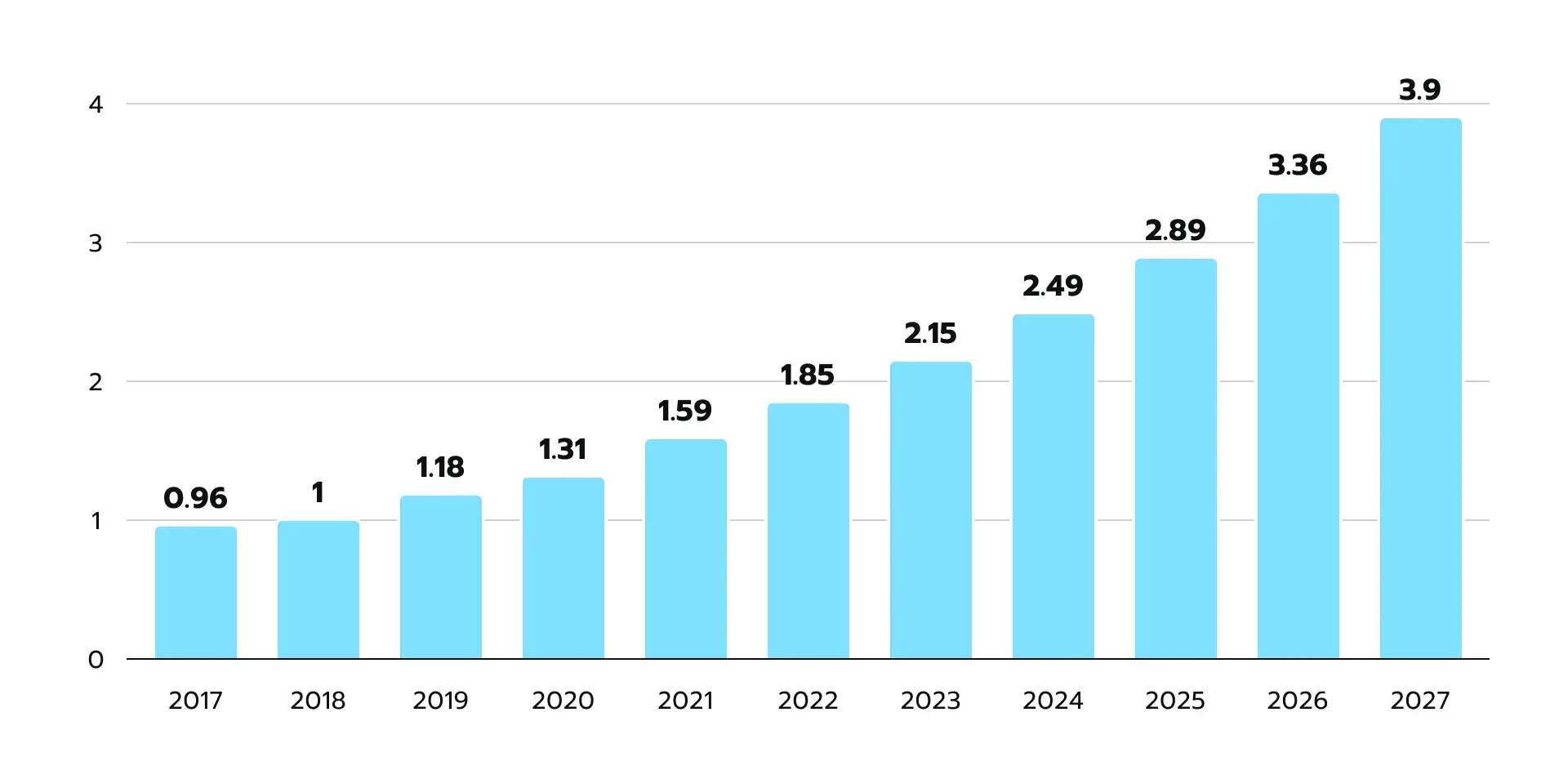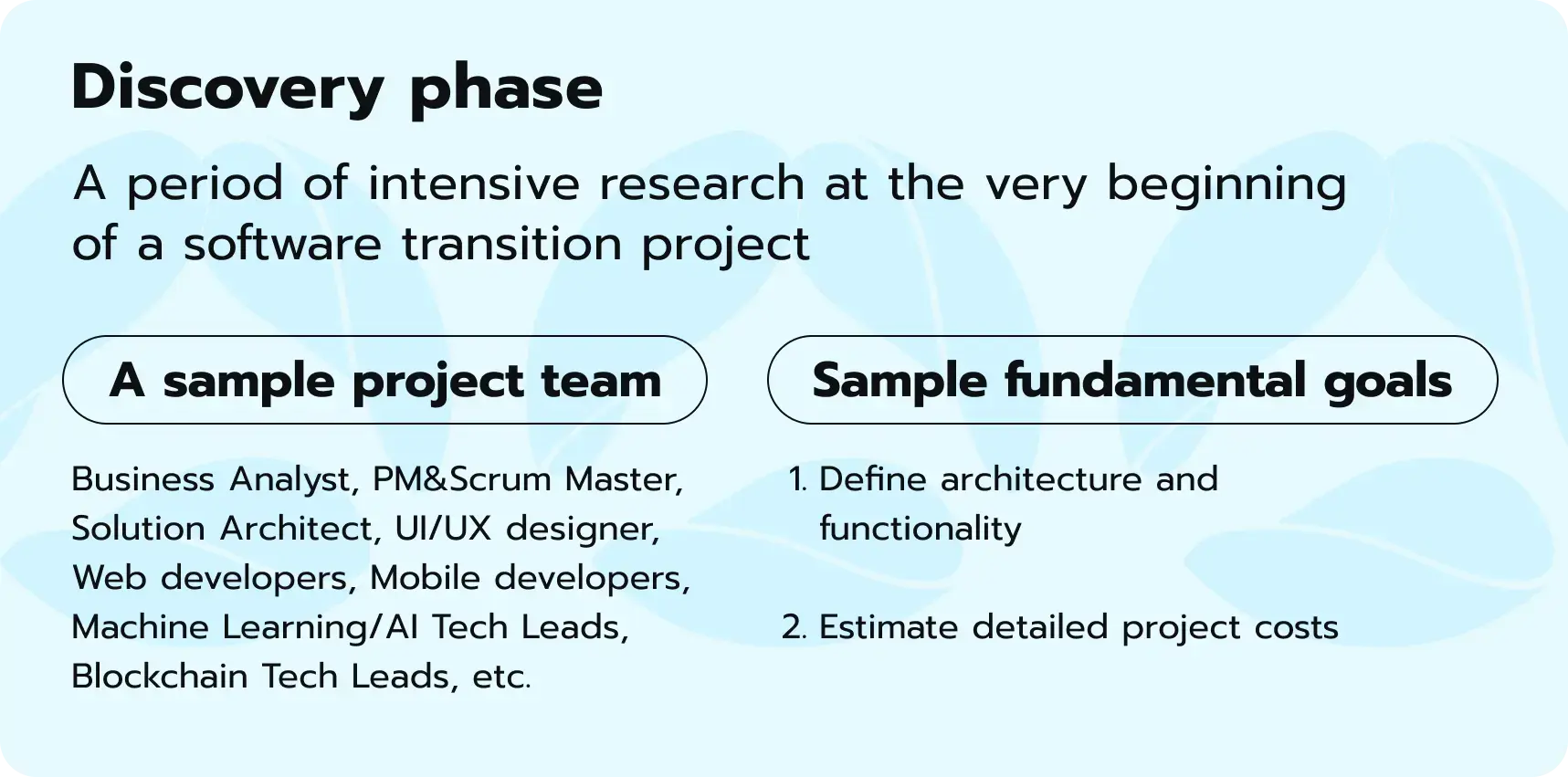How to make a cross-functional team thrive and what value it brings
Learn how to build a cross-functional team and how they can spur innovation, foster collaboration, and accelerate problem-solving in your business.

What software transition plan represents and steps to upgrade to new software.
In today’s rapidly evolving business landscape, the adoption of new software tools has become imperative for companies striving to stay competitive. According to the IDC Spending Guide Worldwide Digital Transformation Investments, it will reach $3.4 trillion in 2026. Yet, despite significant investment in cutting-edge technologies, many organizations fail in their project transition planning. This oversight not only hampers productivity but also undermines the potential benefits of the newly acquired solutions.
A successful software development project transition plan entails more than just acquiring a technological solution; it demands a strategic approach encompassing seamless integration, comprehensive business process reengineering, and user-centric design. Here, we delve into the intricacies of effective software transition and outline key strategies to help ensure a smooth and successful adaptation.
Transitioning to new software marks a significant shift in an organization’s operational dynamics. Whether a project implies migrating to cloud-based platforms, implementing enterprise resource planning (ERP) systems, or adopting innovative customer relationship management (CRM) solutions, the transition invariably disrupts established workflows and routines. Recognizing this, companies must approach the transition phase with a clear understanding of the purpose of the entire transition and its implications and challenges.
According to Harvard Business Review (HBR), the value of digital transformation lies not only in the adoption of new technologies but also in the organizational change it drives. Successful digital transformations prioritize agility, innovation, and customer-centricity, aligning technology initiatives with broader business objectives, and software transition plays a crucial role in that. Additionally, McKinsey & Company highlights the importance of leadership commitment, project management, and organizational capabilities in embracing new technologies and workflows. Leaders must champion change, foster a culture of continuous learning, and empower employees to embrace new technologies and working methods. Figure 1. Spending on digital transformation technologies and services worldwide from 2017 to 2027 (in trillion U.S. dollars)
Figure 1. Spending on digital transformation technologies and services worldwide from 2017 to 2027 (in trillion U.S. dollars)
Essentially, a software transition is a foundational element of digital transformation that supports the overall goal of making business processes more agile, data-driven, and customer-centric. It enables organizations to use new technologies that will help modernize their operations and stay competitive.
Software transition enhances operational efficiency because it automates manual processes and reduces errors. It can also help businesses quickly adapt to market changes and customer demands, making them more flexible. Software transition often brings in new capabilities, allowing businesses to innovate and offer new services or improve existing ones. It facilitates integration, improves security and leads to overall better business optimization.
Organizational change management (OCM) is critical for ensuring a smooth transition during the project handover. An effective change management plan is essential to mitigate resistance, maximize adoption, and facilitate the successful integration of new software systems within an organization. By proactively addressing concerns, communicating the benefits, and involving stakeholders throughout the transition process, organizations can foster a culture of openness, collaboration, and readiness for the perfect transition.
Providing comprehensive training and support resources, establishing clear communication channels, and soliciting user feedback can help identify and address challenges early on, ensuring a seamless transition and optimizing the overall effectiveness of the software solution. Ultimately, prioritizing organizational change management ensures that your transition plan is technically successful and positively impacts productivity, efficiency, and organizational performance in the long run. Figure 2. Stages of conducting a correct project transition.
Figure 2. Stages of conducting a correct project transition.
A successful transition hinges on meticulous planning and execution. Leveraging insights from industry experts and real-world experiences, organizations can adopt the following strategies to navigate the complexities of software integration:
Creating a transition plan template begins with conducting a comprehensive assessment of the company’s app ecosystem and identifying areas for improvement. This entails evaluating existing workflows, pinpointing potential challenges, and defining clear objectives for the new applications.
Effective communication and collaboration are paramount during the transition stage. Engaging all team members from a project team and key stakeholders in the decision-making and implementation phases fosters buy-in and ensures alignment with organizational goals.
Transitioning to new systems often necessitates upskilling or reskilling employees to leverage their full potential. Investing in robust training programs tailored to the specific needs of end-users enhances proficiency and minimizes resistance to change.
Seamless data migration is critical to preserving the integrity and accessibility of organizational information while modifications or changes are being implemented. Companies must devise meticulous data migration strategies and ensure compatibility and interoperability between the new and existing systems.
Adopting an iterative technological implementation approach allows organizations to identify and address issues proactively. Establishing feedback mechanisms and soliciting end-user input enable continuous improvement and refinement of the transition process.
Software transitioning may seem a lengthy process, but it’s a regular practice. To make it easier, documentation of all objectives, tools and tech details is needed. And, even if you may come across some challenges, you can overcome them with the technology adoption strategies from the next section.
A good project transition plan requires comprehensive technology adoption strategies. A proper technology adoption happens when employees are able to utilize all features of an app. So, it includes encouraging a digital-friendly culture and training the staff. Adoption of new technology within an organization requires a multifaceted approach.
Choosing technology that aligns with business objectives is paramount for the software transition. Conducting thorough evaluations of potential software solutions, soliciting end-user input, and conducting pilot tests can help identify the most suitable technology for the organization’s unique requirements.
You need to know if new tech can be integrated with the old before adding it. You should understand what your system lacks and how new technology can fill in those gaps to prevent any setup issues during software transition.
User training programs should be tailored to employees’ needs and skill levels. By planning your training programs beforehand, you can minimize the disruption caused by new technologies facilitating the transition from one tool to another. Providing hands-on training sessions, online tutorials, and access to support resources enhances user proficiency and confidence in using the new application.
Effective change management practices are essential for overcoming resistance to change and fostering a culture of innovation. Leaders should communicate the rationale behind adopting technology, solicit feedback from employees, and promptly address concerns or misconceptions. Moreover, recognizing and rewarding early adopters can incentivize broader acceptance and participation during the transition.
You could analyze what users liked about their training programs and create a similar plan to learn new tools during the software transition project. By listening to your employees’ opinions and adjusting your roadmap, you can make the adoption process successful. Also, by monitoring what each team has achieved with particular tech, you can measure return on the investment.
Successful tech adoption improves your workflow and user experience and makes business operations more efficient. Moreover, companies which take care of user adoption are better prepared for unprecedented change during the transition process. Good communication, management support and tailored training are the keys to successful technology adoption.
Learn more about how we helped our client elevate logistics risk management with advanced technologies. Success story
Before embarking on the software transition journey, organizations must undergo a comprehensive discovery phase, another milestone for laying the groundwork for success. Discovery phase serves as a crucial prelude to the planning of both software development and transition, enabling stakeholders to gain a deep understanding of the existing business processes, potential risks, and requirements.
 Figure 3. What underlies a discovery phase.
Figure 3. What underlies a discovery phase.
Usually, the discovery phase starts with a target market overview which includes the analysis of its size, trends, customer segments and growth potential. Thus, a company has a better insight into the software it needs.
Analysis of main competitors in the market and their strong and weak points is essential in software transition. It will help to discover differentiation areas and understand in which direction the company should move.
Software transition at the discovery phase requires a comprehensive list of functionalities and features for the software. It will serve as a road-map for the development team.
A document with product vision presents information about general goals of the project, offers solutions and showcases the potential and prospects. All stakeholders engaged in the development process can benefit from it during the transition process.
The next stage in the software transition project is designing a high-level outline showing the architecture of the software and how its various parts function together and interact.
At this point, a company decides which tools, frameworks and technologies have to be used to create the software product. It lays the groundwork of the development process during transition.
A company needs to define the responsibilities and levels of experience needed for the development team. It outlines the skill sets required to complete the project effectively.
Another important step in the software transition project is a graphic representation of how a user might engage with the product. It incorporates all suggested points and avenues for interaction as well as the client’s imagined experience, which will allow the design of a user-centric product.
It’s developed as schematic screens of the software solution and transitions between them to ascertain how the user will interact with the new product’s interface. The visual interface prototypes project the scenarios of user behavior.
It’s essential to provide a budget for the transition project which will cover developmental and other costs. It also includes a chronology of the project, with important deadlines and benchmarks highlighted.
Choosing a proper technology partner is paramount as they play a multifaceted role in software transition. A capable partner can also assist with every aspect of the discovery phase, from conducting thorough research and stakeholder interviews to identifying key objectives and success criteria for the new tool.
Software transition initiatives must go through a crucial discovery phase to survive and prosper. Establish the project’s goals, compile its needs, and investigate potential solutions to guarantee that all parties are in agreement. User-centric solutions and effective development procedures are the result of thorough user research and risk minimization. Businesses can undergo a software transition successfully by adopting a discovery phase.
A project’s discovery phase lays the foundation for successful software transition. Stakeholders get an insight into the project’s objectives and expected outcomes after a thorough analysis of project requirements, technical specifics, user needs and potential challenges. It brings them onto the same page regarding the budget, project scope and timeline.
Apart from improving alignment with stakeholders, reducing costs and possibilities of risks, the discovery phase enhances the user experience with the help of customer journey maps and user flow representation, which in turn improve a project’s return on investment by making higher conversion rates and enhancing customer satisfaction. Choosing the right software development company for partnership also improves the chances for success in the software transition journey as its experience and expertise help navigate the complexities of a software transition.
As the discovery phase helps to create a comprehensive plan of a project no wonder it is often a mandatory requirement during software transition. With its help the final product will both meet the end-user’s needs and match the client’s expectations.
Transitioning to new software is crucial for organizations seeking to innovate and adapt to evolving market demands. By prioritizing meticulous planning, stakeholder engagement, business process reengineering, user-centric design, and the discovery phase, companies can overcome software integration challenges and unlock new opportunities for growth and success in the digital era.
As technology continues to reshape the business landscape, embracing change and partnering with experts that can provide comprehensive support throughout the transition journey will remain essential for staying ahead of the curve and driving sustainable growth in today’s dynamic environment. If your organization needs help with updating its operational flows to higher standards of software performance, contact us for a free consultation with our software development experts.
* US and Canada, exceptions apply
Ready to innovate your business?
We are! Let’s kick-off our journey to success!